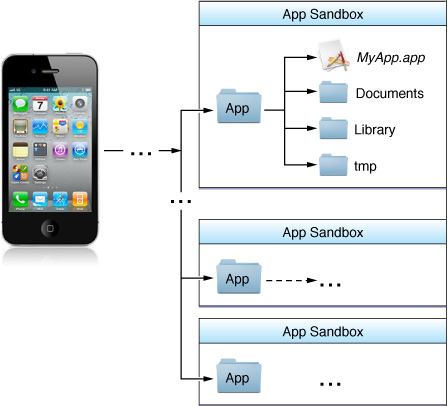iOS App 升级时文件的保留情况
来源:互联网 发布:网络咨询话术 编辑:程序博客网 时间:2024/05/29 17:41
有这样一个问题,用户用iOS设备下载了大量的数据,保存在设备本地,如果用户升级了应用本身,这些文件是否仍然存在。
找了一些官方解释和Stackflow上的说明
Where You Should Put Your App’s Files
To prevent the syncing and backup processes on iOS devices from taking a long time, be selective about where you place files inside your app’s home directory. Apps that store large files can slow down the process of backing up to iTunes or iCloud. These apps can also consume a large amount of a user's available storage, which may encourage the user to delete the app or disable backup of that app's data to iCloud. With this in mind, you should store app data according to the following guidelines:
Put user data in the <Application_Home>/Documents/. User data is any data that cannot be recreated by your app, such as user documents and other user-generated content.
Handle support files—files your application downloads or generates and can recreate as needed—in one of two ways:
In iOS 5.0 and earlier, put support files in the <Application_Home>/Library/Caches directory to prevent them from being backed up
In iOS 5.0.1 and later, put support files in the <Application_Home>/Library/Application Support directory and apply thecom.apple.MobileBackup extended attribute to them. This attribute prevents the files from being backed up to iTunes or iCloud. If you have a large number of support files, you may store them in a custom subdirectory and apply the extended attribute to just the directory.
Put data cache files in the <Application_Home>/Library/Caches directory. Examples of files you should put in this directory include (but are not limited to) database cache files and downloadable content, such as that used by magazine, newspaper, and map apps. Your app should be able to gracefully handle situations where cached data is deleted by the system to free up disk space.
Put temporary data in the <Application_Home>/tmp directory. Temporary data comprises any data that you do not need to persist for an extended period of time. Remember to delete those files when you are done with them so that they do not continue to consume space on the user’s device.
<Application_Home>/Library/
This directory is the top-level directory for files that are not user data files. You typically put files in one of several standard subdirectories but you can also create custom subdirectories for files you want backed up but not exposed to the user. You should not use this directory for user data files.
The contents of this directory (with the exception of the Caches subdirectory) are backed up by iTunes.
For additional information about the Library directory, see “The Library Directory Stores App-Specific Files.”
Library目录下面的内容,也会被被iTunes备份,但是Caches目录除外,也就是说这些网络下载内容文件放在这里是不会被备份的,
Caches
Use this directory to write any app-specific support files that your app can re-create easily. Your app is generally responsible for managing the contents of this directory and for adding and deleting files as needed.
In iOS 2.2 and later, the contents of this directory are not backed up by iTunes. In addition, iTunes removes files in this directory during a full restoration of the device.
On iOS 5.0 and later, the system may delete the Caches directory on rare occasions when the system is very low on disk space. This will never occur while an app is running. However, you should be aware that iTunes restore is not necessarily the only condition under which the Caches directory can be erased.
上面写的的比较清楚,Library/Caches目录下,一般情况下是不会被删除的,我理解,也包括stackoverflow网友的证明,应用升级的时候也不会被删除,实际上,应用升级的具体系统操作是这样的:
Files Saved During Application Updates When a user downloads an application update, iTunes installs the update in a new application directory. It then moves the user’s data files from the old installation over to the new application directory before deleting the old installation. Files in the following directories are guaranteed to be preserved during the update process:
- Application_Home/Documents
- Application_Home/Library
Although files in other user directories may also be moved over, you should not rely on them being present after an update.
系统先新建一个应用目录,然后安装一个新版本应用,然后再把旧版本的应用数据拷贝过来,然后再删除旧版本的应用安装目录。
最后注意一下,Library/Caches目录下的数据虽然在一般情况下不会被删除,但是在系统恢复和其他一些罕见的情况下(比如非常底的磁盘空间条件下有可能)会被清除,所以你的程序每次都要检查一些,这些文件都还在不在了,不在的话只能重新下了。
Application_Home/Library/Caches Use this directory to write any application-specific support files that you want to persist between launches of the application or during application updates. Your application is generally responsible for adding and removing these files. It should also be able to re-create these files as needed because iTunes removes them during a full restoration of the device. In iOS 2.2 and later, the contents of this directory are not backed up by iTunes.
参考连接:http://stackoverflow.com/questions/7155964/will-application-home-library-caches-be-clear-on-app-update/7277797#7277797
File System Programming Guide
https://developer.apple.com/library/ios/documentation/FileManagement/Conceptual/FileSystemProgrammingGuide/FileSystemOverview/FileSystemOverview.html#//apple_ref/doc/uid/TP40010672-CH2-SW1
- iOS App 升级时文件的保留情况
- iOS App 升级时文件的保留情况
- iOS App 升级时文件的保留情况
- iOS App 升级时文件的保留情况
- iOS学习笔记49-iOS App 升级时文件的保留情况
- iOSAPP升级时文件的留存问题
- IOS 程序升级--文件保留情况
- 下载信息内容时文件名称的指定
- 系统安装时文件系统的选择
- DFU升级新固件时保留旧的App data
- 谈谈Android App运行时文件系统路径问题
- iOS beta固件升级的坑
- ios开发之APP升级的实现
- ios开发之APP升级的实现
- IOS APP 升级安装-coredata 的迁移,升级
- 部署基于OpenCV的程序需要的运行时文件
- ios开发 升级App
- ios升级app
- J2EE基础:Struts框架的初学者入门知识
- repo使用
- 《JAVA网络编程》阅读笔记(一)
- C语言标准库函数 qsort 详解
- javascript Date format(js日期格式化)
- iOS App 升级时文件的保留情况
- Hibernate 面试中最常考察的知识点整合
- 循环-24. 求给定序列前N项和之二
- 安卓屏幕代码适配屏幕心得px和dp;sp和dp选择
- iPhone开发之UIScrollView滚动组件的使用(五) 通过代理监听滚动事件
- 数组的查找定位
- MPMoviePlayerViewController或MPMoviePlayerCont _itemFailedToPlayToEnd: { kind = 1; new = 2; old = 0;
- 快速排序
- Android应用程序窗体显示状态requestWindowFeature()



